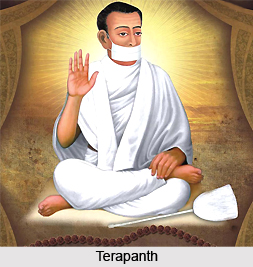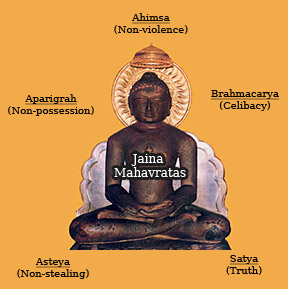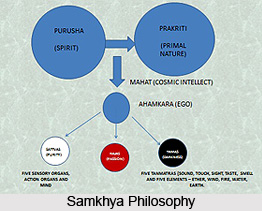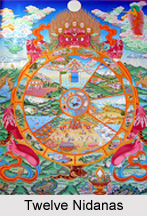 The Terapanth denomination was founded by the eighteenth century Swetambara reformer, Acharya Bhikshu. He is one of the best-documented figures in the history of Jainism. Acharya Bhikshu was born in 1726 in the desert region of Marwar in Rajasthan. He belonged to the Bisa Oswal caste. He took his initiation in 1751 as a Sthanakvasi monk under Acharya Raghunathji. According to him the Jain path could only involve total dedication. He later detached himself as a Sthanakvasi monk as he though it had a host of imperfections. Thus he broke away from it in 1759.
The Terapanth denomination was founded by the eighteenth century Swetambara reformer, Acharya Bhikshu. He is one of the best-documented figures in the history of Jainism. Acharya Bhikshu was born in 1726 in the desert region of Marwar in Rajasthan. He belonged to the Bisa Oswal caste. He took his initiation in 1751 as a Sthanakvasi monk under Acharya Raghunathji. According to him the Jain path could only involve total dedication. He later detached himself as a Sthanakvasi monk as he though it had a host of imperfections. Thus he broke away from it in 1759.
Forming of Terapanth
The full community of Terapanthis, including lay supporters, was formed in 1765. Acharya Bhikshu formed the Terapanth along with thirteen other monks who pursued him. The monks of Terapanth under their leader undertook elaborate and long fasting and observed the strictest ahimsa, i.e. tying the muhpatti all the time. Bhikshu made a difference between laukika (worldly) and lokottara (transcendent) religious practices. In its history of little more than 200 years, the Terapanth had a succession of only 9 Acharyas from the founding father Acharya Bhikkanaji as the First Acharya to Acharya Tulsi as the 9th Acharya.
The Terapantha regularly observes a notable festival known as Maryada Mahotasava. It is celebrated every year on the 7th day of the bright half of the month of Magha. On this day all monks and lay followers, both male and female, meet together at one predetermined place and discuss the different problems of Terapanthis.
Terapanth under Acharya Tulsi
When Acharya Bhiksu died in 1803, he had initiated fifty-six nuns and forty nine monks. The members of Terapanth insisted on the centrality of the Acharya. Acharya Tulsi, the Ninth acharya was responsible for the high profile of the denomination in post-independence India. He is credited with carrying out the largest number of initiations of any Terapanthi Acharya. He was the first person to plan for the first Jain University in Ladnun, his birthplace in Rajasthan. In 1949, he established the Anuvrata Movement. It was dedicated for the upliftment of the ethical tone of Indian public and commercial life by taking Jainism beyond the Jains.
The penance of Terapanthis is very severe. The dress of Terapanthi monks and nuns is akin to that of Sthanakvasi monks and nuns. There is a difference in the length of muhapatti, i.e., a piece of white cloth kept always on the mouth. The Terapanthis do not believe in idol worship and give importance to the practice of meditation. The Terapantha is known for its disciplined organization and is characterized by one Acharya, one code of conduct and one line of thought. The Terapanthis are regarded as reformists as they emphasize simplicity in religion. The Terapanthis do not construct monasteries for their monks. Instead they inhabit a part of the house which the householders build for themselves.
Terapanth under Yuvacharya Mahaprajna
Acharya Tulsi`s successor Yuvacharya Mahaprajna led another Terapanthi innovation, prekshadhyana, `insight- meditation.` It was the growth of a modern form of Jain meditation which was designed to ``engage the mind fully in the perception of subtle, internal and innate phenomenon of consciousness." According to Dundas "this system, takes its inspiration from scattered scriptural statement about perceiving the self with the self, while also drawing eclectically on a wide range of sources in other traditions, provides a meditative structure...for a religion which seems to have lost contact with its original system of contemplation at least one thousand years ago."
Another noteworthy feature of the Terapanth was the willingness to break away from the Jain`s prohibition of monks travelling into `non-Aryan` lands. In Terapanth lower-order male and female ascetics known as saman and samani are trained and granted special permission to travel abroad. Though they also take the five Great Vows, they are unlike normal monks. The monks are allowed to use mechanical means of transport and to accept food, which has been specially prepared for them.
The Terapanthis are still limited in number. Even though they are noticed in different cities in India, they are concentrated chiefly in Bikaner, Jodhpur and Mewar regions of Rajasthan.



















